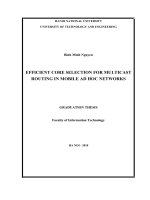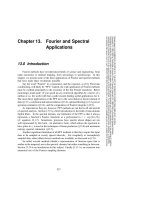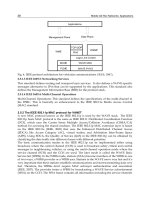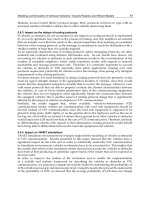Mobile Ad Hoc Networks Applications Part 1 ppt
Bạn đang xem bản rút gọn của tài liệu. Xem và tải ngay bản đầy đủ của tài liệu tại đây (3.38 MB, 35 trang )
MOBILE ADͳHOC
NETWORKS:
APPLICATIONS
Edited by Xin Wang
Mobile Ad-Hoc Networks: Applications
Edited by Xin Wang
Published by InTech
Janeza Trdine 9, 51000 Rijeka, Croatia
Copyright © 2011 InTech
All chapters are Open Access articles distributed under the Creative Commons
Non Commercial Share Alike Attribution 3.0 license, which permits to copy,
distribute, transmit, and adapt the work in any medium, so long as the original
work is properly cited. After this work has been published by InTech, authors
have the right to republish it, in whole or part, in any publication of which they
are the author, and to make other personal use of the work. Any republication,
referencing or personal use of the work must explicitly identify the original source.
Statements and opinions expressed in the chapters are these of the individual contributors
and not necessarily those of the editors or publisher. No responsibility is accepted
for the accuracy of information contained in the published articles. The publisher
assumes no responsibility for any damage or injury to persons or property arising out
of the use of any materials, instructions, methods or ideas contained in the book.
Publishing Process Manager Iva Lipovic
Technical Editor Teodora Smiljanic
Cover Designer Martina Sirotic
Image Copyright Supri Suharjoto, 2010. Used under license from Shutterstock.com
First published January, 2011
Printed in India
A free online edition of this book is available at www.intechopen.com
Additional hard copies can be obtained from
Mobile Ad-Hoc Networks: Applications, Edited by Xin Wang
p. cm.
ISBN 978-953-307-416-0
free online editions of InTech
Books and Journals can be found at
www.intechopen.com
Chapter 1
Chapter 2
Chapter 3
Chapter 4
Chapter 5
Chapter 6
Chapter 7
Part 2
Chapter 8
Preface IX
Vehicular Ad Hoc Networks 1
Survey on Multi-hop Vehicular Ad Hoc Networks
under IEEE 802.16 Technology 3
Gabriel Alejandro Galaviz Mosqueda, Raúl Aquino Santos,
Luis A. Villaseñor González, Víctor Rangel Licea
and Arthur Edwards Block
Communications in Vehicular Networks 19
Zaydoun Yahya Rawashdeh and Syed Masud Mahmud
Modeling and Simulation of Vehicular Networks:
Towards Realistic and Efficient Models 41
Mate Boban and Tiago T. V. Vinhoza
Security Issues in Vehicular Ad Hoc Networks 67
P. Caballero - Gil
Routing in Vehicular Ad Hoc Networks:
Towards Road-Connectivity Based Routing 89
Nadia Brahmi, Mounir Boussedjra and Jospeh Mouzna
Traffic Information Dissemination
in Vehicular Ad Hoc Networks 107
Attila Török, Balázs Mezny and Péter Laborczi
CARAVAN: Context-AwaRe Architecture for VANET 125
Sławomir Kukliński and Grzegorz Wolny
Security and Caching in Ad Hoc Networks 149
Trust Establishment in Mobile Ad Hoc Networks:
Key Management 151
Dawoud D.S., Richard L. Gordon,
Ashraph Suliman and Kasmir Raja S.V.
Contents
Contents
VI
Grouping-Enabled and Privacy-Enhancing
Communications Schemes for VANETs 193
T.W. Chim, S.M. Yiu, Lucas C.K. Hui and Victor O.K. Li
APALLS: A Secure MANET Routing Protocol 221
Sivakumar Kulasekaran and Mahalingam Ramkumar
Meta-heuristic Techniques
and Swarm Intelligence in Mobile Ad Hoc Networks 245
Floriano De Rango and Annalisa Socievole
Impact of the Mobility Model
on a Cooperative Caching Scheme
for Mobile Ad Hoc Networks 265
F.J. Gonzalez-Cañete and E. Casilari
Applications of Ad Hoc Networks 287
Ad Hoc Networks for Cooperative Mobile Positioning 289
Francescantonio Della Rosa, Helena Leppäkoski,
Ata-ul Ghalib, Leyla Ghazanfari, Oscar Garcia,
Simone Frattasi and Jari Nurmi
Ad-hoc Networks
As an Enabler of Brain Spectroscopy 305
Salah Sharieh
MANET Mining: Mining Association Rules 323
Ahmad Jabas
Wired/Wireless Compound Networking 349
Juan Antonio Cordero, Emmanuel Baccelli,
Philippe Jacquet and Thomas Clausen
Multiple Multicast Tree Construction
and Multiple Description
Video Assignment Algorithms 375
Osamah Badarneh and Michel Kadoch
TCP in Ad Hoc Networks 399
TCP-MAC Interaction
in Multi-hop Ad-hoc Networks 401
Farzaneh R. Armaghani and Sudhanshu S. Jamuar
The Effect of Packet Losses and Delay
on TCP Traffic over Wireless Ad Hoc Networks 427
May Zin Oo and Mazliza Othman
Chapter 9
Chapter 10
Chapter 11
Chapter 12
Part 3
Chapter 13
Chapter 14
Chapter 15
Chapter 16
Chapter 17
Part 4
Chapter 18
Chapter 19
Contents
VII
Other Topics 451
A Survey on The Characterization of the Capacity
of Ad Hoc Wireless Networks 453
Paulo Cardieri and Pedro Henrique Juliano Nardelli
Design and Analysis of a Multi-level Location Information
Based Routing Scheme for Mobile Ad hoc Networks 473
Koushik Majumder, Sudhabindu Ray and Subir Kumar Sarkar
Power Control in Ad Hoc Networks 489
Muhammad Mazhar Abbas and Hasan Mahmood
Part 5
Chapter 20
Chapter 21
Chapter 22
Pref ac e
Mobile Ad hoc Networks (MANETs) are a fundamental element of pervasive networks,
where user can communicate anywhere, any time and on-the-fl y. MANETs int roduce
a new communication paradigm, which does not require a fi xed infrastructure - they
rely on wireless terminals for routing and transport services. This edited volume
covers the most advanced research and development in MANET. It seeks to provide an
opportunity for readers to explore the emerging fi elds about MANET.
It includes fi ve parts in total. Part 1 discusses the emerging vehicular ad-hoc networks.
Part 2 focuses on the security and caching protocols. Part 3 introduces some new
applications for MANET. Part 4 presents novel approaches in transport-layer protocol
design. Some interesting topics about network capacity, power control, etc. are
discussed in Part 5.
Acknowledgements
The editors are particularly grateful to the authors who present their work in this book.
They would also like to express their sincere thanks to all the reviewers, who help
to maintain the high quality of this book. We hope that the readers will share our
excitement to present this volume on ad-hoc networks and will fi nd it useful.
Prof. Xin Wang
University of California, Santa Cruz,
USA
Part 1
Vehicular Ad Hoc Networks
1
Survey on Multi-hop Vehicular Ad Hoc Networks
under IEEE 802.16 Technology
Gabriel Alejandro Galaviz Mosqueda
1
, Raúl Aquino Santos
2
, Luis A.
Villaseñor González
1
, Víctor Rangel Licea
3
and Arthur Edwards Block
2
1
Centro de Investigación Científica y Educación Superiore de Ensenada. Carretera
Ensenada-Tijuana, núm. 3918, Zona playitas, C. P. 22860, Ensenada, Baja California,
2
Facultad de Telemática, Avenida Universidad 333, C. P. 28040, Colima, Col.,
3
Facultad de Ingeniería, Edificio Valdez Vallejo, 3er piso, Circuito Interior, Ciudad
Universitaria, Delegación Coyoacán, C. P. 04510,
México
1. Introduction
Today, there are many existing technologies designed to make vehicular road travel safer,
easier and more enjoyable, using geographical positioning system, proximity sensors,
multimedia communication, etc. The current data transmission requirements of these
technologies, unfortunately, place great demand on both the algorithms and equipment,
which often perform less than optimally, especially when having to interact with other
vehicles. For example, GPS can trace a route to a specific location, but does so without
taking into account some very important variables such as congestion caused by road
conditions, high traffic volume and traffic accidents, which can entirely block one-lane
traffic and affect two-lane traffic by almost 65% [1].
Presently, GPS permits users to obtain real-time location information. However, expanded
communications among vehicles and with roadside infrastructure can substantially expand
services drivers currently enjoy in the areas of traffic flow, safety, information (Internet),
communications (VoIP) and comfort applications, among others [2].
According to Sichitiu et al. applications for vehicular communications include the following:
• Proactive safety applications: geared primarily to improve driver reaction and decision
making to avoid possible accidents (e.g. broadcast warnings from a vehicle that has
ignored red stop light) or minimize the impacts of an imminent crash (automated
braking systems).
• Traffic management applications: mainly implemented to improve traffic flow and
reduce travel time, which is particularly useful for emergency vehicles.
• Traffic coordination and traffic assistance: principally concerned with improving the
distribution and flow of vehicles by helping drivers pass, change lanes, merge and form
columns of vehicles that maintain constant relative speeds and distances (platooning).
• Traveler Information Support: mainly focused on providing specific information about
available resources and assistance persons require, making their traveling experience
less stressful and more efficient.
Mobile Ad-Hoc Networks: Applications
4
• Comfort Applications: primarily designed to improve the travel experience of the
passengers and the driver (e.g. gaming, internet, automatic tolls, etc.)
Figure 1 shows some potential applications.
Fig. 1. Some potential services to be offered by vehicular communication networks
In order to provide greater passenger safety, convenience and comfort, protocols and
equipment must provide more timely and reliable data transfer between network nodes for
them to effectively share vital information. In the case of WiMAX, network nodes must
efficiently transmit and receive data in a instantaneously changing network environment,
characterized by the constant entry and exit of nodes. In addition, mobile nodes must
handle handoffs between different clusters, all while functioning within very strict technical
parameters regarding packet loss, delay, latency, and throughput, among others.
Sichitiu and Kihl in [3] construct a taxonomy based on the way nodes exchange data. Their
work involves two forms of vehicular communication: vehicle to vehicle (IVC) and vehicle
to roadside (RVC). IVC can employ either a one hop (SICV) or multi-hop (MIVC) strategy.
On the other hand, RVC can be ubiquitous (URVC) or scarce (SRVC). Figure 2 schematizes
these authors’ taxonomy [3]. The following three figures explain this taxonomy and provide
examples of IVC, RVC and HVC.
Communications within VANETs can be either inter-vehicular or vehicle to roadside and
each type of communication imposes its specific requirements. For example, highway
collision warning systems can more easily be implemented using multi-hop
communications between vehicles (without infrastructure). On the other hand, traveller
information requires fixed infrastructure to provide connectivity between the vehicles and
Survey on Multi-hop Vehicular Ad Hoc Networks under IEEE 802.16 Technology
5
Fig. 2. Vehicular communications Taxonomy
Fig. 3. An IVC example
an information center. IVC deployment is significantly less expensive than RVC because it is
infrastructureless. This kind of architecture allows vehicles to send information between each
other via multi-hop communication, even with vehicles that are beyond their immediate radio
coverage area. IVC internet access is much more complicated than with RVC. As a result, IVC
can only provide a reduced number of applications. However, IVC is better suited for safety
applications because the vehicles can almost immediately detect collision or congestion
warning that is transmitted within the affected area. Figure 3 provides an example of inter
vehicular communication, where a vehicle approaching an accident detects the crash and
Mobile Ad-Hoc Networks: Applications
6
informs the vehicles behind it that it is about to brake suddenly. This forewarning could help
avoid other accidents caused by drivers who cannot apply their brakes opportunely and
allows vehicles further behind to change lanes to lessen traffic congestion.
RVC can offer a wider range of applications because of its more stable and robust access to
the Internet, which allows ready availability of information about specific places and the
services they provide. RVC, however, has two important drawbacks when considered for
safety applications:
• the cost of deployment of base stations (BS) makes it difficult to provide full coverage
for so many vehicles over such a large area as vehicles leaving the BS coverage area lose
connectivity.
• the delay caused by sending packets through a base station can prove disastrous in time
sensitive safety applications.
Different technologies have been tested to enable RVC, including cellular, WiFi (IEEE
802.11p) and WiMAX (IEEE 802.16e), but no standard has been established as of yet.
Presently, authors believe that WiMAX best fits VCN requirements because of its high
bandwidth, robust medium access control (MAC), versatility (i.e. wide range of compatible
standards) and QoS support. Importantly, it meets the already existing standard for mobile
nodes (IEEE 802.16e). Figure 4 illustrates examples of some RVC applications, which include
broadcasting the location of specific businesses and providing information about goods and
services offered by them.
Fig. 4. A RVC network example
Survey on Multi-hop Vehicular Ad Hoc Networks under IEEE 802.16 Technology
7
Fig. 5. A mixture of IVC and RVC (HVC)
Both IVC and RVC have desirable benefits; while with IVC users can form groups
practically anywhere, with RVC persons can have access to internet and extend the
vehicular applications. Importantly, combining both of these architectures into a hybrid
vehicular communications (HVC) network can maximize benefits. HVC, however, is more
complex in various aspects: HVC need more complex routing protocols, a robust physical
layer and a medium access layer that is sufficiently dynamic to fully exploit the short
duration of links and organized enough to minimize interference.
Figure 5 illustrates a hybrid vehicular communication network where vehicles inside the
coverage area of a RVC can act as gateways for vehicles outside the coverage area. HVC
networks are very desirables because they can provide virtually any kind of service.
Importantly, however, as previously mentioned, research must first overcome many
technical challenges before HVC networks can be implemented in real-world applications.
This is primarily because of the incompatibility of technologies (e.g. WiFi was developed for
WLANs, while cellular communications were designed for WANs).
As previously mentioned, each type of vehicular communications (IVC, RVC or HVC) has
different technological requirements, although they all must meet several common demands
inherent in VCN (see Table 1 and Figure 6). Three of these network requirements include [4]:
• radio transceiver technology that provides omni-directional coverage
• rapid vehicle-to-vehicle communications to keep track of dynamic topology changes
• highly efficient routing algorithms that fully exploit network bandwidth
Mobile Ad-Hoc Networks: Applications
8
Fig. 1. Types of scenarios for VCN
Rural Urban City Highway
Speed
Low Medium/High Low/Very Low Very high
Vehicles Density
Low Medium Very high Med/Low
Interference
Low Medium Very high Low
Infrastructure
Low Medium Very high Med/Low
Table 1. Features of Vehicular Scenarios
Numerous researchers have worked to overcome issues related to vehicular
communications (e.g. [5-9, 10-12]). In 2004, the IEEE group created the IEEE 802.11p
(wireless access in vehicular environments-WAVE) task force [13]. The workforce
established a new standard that essentially employs the same PHY layer of the IEEE 802.11a
standard, but uses a 10 MHz channel bandwidth instead of the 20 MHz used in IEEE
802.11a. With respect to the MAC layer, WAVE is based on a contention method (i.e.
CSMA/CA), similar to other standards in this group.
The MAC layer in IEEE 802.11p has several significant drawbacks. For example, in vehicular
scenarios, WAVE drops over 53% of packets sent according to simulation results [14].
WAVE also has a limited transmission range; simulations carried out by [15] show that only
1% of communication attempts at 750m are successful in a highway scenario presenting
multipath shadowing. Furthermore, results in [16] show that throughput decays as the
number of vehicles increases. In fact, throughput decreases to almost zero with 20
concurrent transmissions. The authors thus conclude that WAVE is not scalable.
Additionally, IEEE 802.11p does not support QoS, which is essential in Vehicular Ad hoc
Networks (VANETs). Importantly, safety applications using VCNs require not only
expanded radio coverage, but also demand minimal delay, robust bandwidth, negligible
packet loss and reduced jitter, among others (see Table 2).
Recently, the IEEE 802.16 taskforce [17, 18] actualized this standard to support QoS,
mobility, and multihop relay communications. Networks using the IEEE 802.16 MAC layer
now can potentially meet a wider range of demands, including VCN.
Worldwide Interoperability for Microwave Access (WiMAX) is a nonprofit consortium
supported by over 400 companies dedicated to creating profiles based on the IEEE 802.16
standard.
Survey on Multi-hop Vehicular Ad Hoc Networks under IEEE 802.16 Technology
9
Application Maximum Required Range (m)
Approaching emergency vehicle warning
~1000
Emergency vehicle signal preemption
~1000
SOS services
~400
Postcrash Warning
~300
Table 2. Maximum required range for some applications in VCN
The first IEEE 802.16 standard considers fixed nodes with line of sight (LOS) between the
base station and each fixed remote node [19]. Later, the IEEE 802.16 task force amended the
original standard to provide mobility to end users (Mobile WiMAX[17]) in non-line-of-sight
(NLOS) conditions. The most recent modification to IEEE 802.16e was in March, 2007, which
later resulted in the IEEE802.16j multihop relay communications protocol, approved in 2009
[18].
IEEE 802.16j operates in both transparent and non-transparent modes. In transparent mode,
mobile stations (MS) must decode the control messages relayed from the base station (BS).
In other words, they must operate within the physical coverage radius of the BS because
relay stations (RS) do not retransmit control information. In non-transparent mode, one of
the RS provides the control messages to the MS. The main difference between transparent
and non-transparent mode architecture is that in transparent mode, RS increase network
capacity while in non-transparent mode, RS extend the BS range. Additionally, RS can be
classified according to their mobility and can be fixed (FRS), nomadic (NRS) or mobile
(MRS) [20].
Despite recent progress in implementing VCN with WiMAX, much work still has to be
done. This work presents proposals that employ IEEE 802.16 as their underlying technology
for multi-hop vehicular communication networks.
This paper is organized as follows: Section II analyzes various proposals suggested by
researchers for VCN using WiMAX networks; Section III presents challenges of using
WiMAX in VCN and Section IV presents conclusions.
2. State of the art of WiMAX in multi-hop vehicular communication networks
The authors in [21] propose a routing protocol called Coordinated External Peer
Communications (CEPEC), whose cross-layer protocol is designed for multi-hop vehicular
networks. They obtained their simulation results using a proprietary development tool
which guaranteed all vehicles fair access to the Internet, even over nodes that were several
hops distant from the BS. Their proposal includes organize the OSI model into three layers:
PHY, MAC and Network. However, the authors do not specify the modifications they made
to the IEEE 802.16-2004 standard that permitted the increased mobility and quicker
registration of the MS. The authors employ TDMA to assign channels, exploiting TDMA’s
centralized scheduler and time division duplexing. Finally, and very importantly, CEPEC
needs to determine the geographic position of every vehicle. To do this, all vehicles must be
equipped with GPS.
An important disadvantage of CEPEC is that it only allows data communication from
vehicles to the BS and vice versa; therefore, it does not provide for vehicle-to-vehicle data
Mobile Ad-Hoc Networks: Applications
10
exchange. Additionally, CEPEC’s centralized scheduling mechanism reduces its scalability.
Since, as previously mentioned, the authors of [21] do not specify the changes they made to
the IEEE 802.16 standard, we must assume that vehicles enter the network according to
standard specifications for nodes in mesh mode. Of course, this implies that network
performance suffers significant deterioration. Also, the authors fail to detail the
modifications they made to the standard that permitted increased mobility and topology
control.
Figure 7 shows the segment configuration of a CEPEC simulation in which the green
vehicles are segment subscriber stations (SSSs) and the red ones are segment heads (SH).
Fig. 7. CEPEC Topology
The authors in [22] do not provide simulation or test bed results and limit their work to
making suggestions at a conceptual level about how to apply a hierarchical topology using
WiFi hotspots (i.e. IEEE 802.11p) as access points for vehicles and WiMAX mesh stations as
access points for WiFi hotspots. One major issue concerning this topology is that the IEEE
802.11p standard does not support QoS and the MAC contention-based method represents a
significant disadvantage.
The topology in [22] is comprised of a point of access (PoA) consisting of a WiMAX mesh
point (MP) and at least one access point (AP). The clusters are formed by several PoAs, one
of which serves as a cluster head (CH) and domain, which is formed by a group of clusters.
Figure 8 schematizes the described topology.
The authors in [23] propose a handoff mechanism called SWIFT, which includes
modification in the MAC and network layers.
Survey on Multi-hop Vehicular Ad Hoc Networks under IEEE 802.16 Technology
11
Fig. 8. Conceptual Architecture of [22]
The objective of the architecture is to provide high speed internet access in trains with a soft
handoff, and having a minimum of connectivity interruptions. This proposal consists of a
three layer topology: Level 0 is an access point functioning under the IEEE 802.11e standard;
Level 1 uses base stations (BS) that work in conjunction with the IEEE 802.16m standard and
Level 2 enables an optical backbone to interconnect with base stations located alongside the
train tracks. Each train possesses two gateway interfaces that serve both as WLAN access
points (i.e. IEEE 802.11e) and IEEE 802.16m subscriber stations. Results obtained using the
popular NS-2 simulator show that the handoff latency of SWiFT is 52% less than with ipV6
mobile.
The SWiFT protocol can be seen as having a vehicle-to-roadside architecture where, as in
[22], there is no possibility of inter-vehicular communications to cause a reduction in
network services. Figure 9 shows the architecture of the SWiFT proposal.
In [24], the authors develop a handoff mechanism with a hybrid architecture using the IEEE
802.16e and IEEE 802.16j standards, which also includes control information of the vehicles
via V2V. In this handoff mechanism, vehicles leaving their relay vehicle coverage area,
called oncoming small size vehicles-OSV, directly transmit the information maintained in
layers 2 and 3 to the vehicles outside the coverage area (called broken vehicles) of the relay
vehicle. The information passed from OSV to BV is necessary to synchronize
communications between the oncoming vehicle and the network.
The NS-2 simulator tool was used in this work and results show that the handoff
mechanism developed helped reduce the handoff latency between relay vehicles. Figure 10
shows the topology described in [24] where the relay vehicles, in this case public buses, are
equipped with IEEE 802.16j, which is used to register the buses at a base station that
Mobile Ad-Hoc Networks: Applications
12
Fig. 9. SWiFT architecture
Fig. 10. A handoff with the VFHS mechanism.
Survey on Multi-hop Vehicular Ad Hoc Networks under IEEE 802.16 Technology
13
Fig. 11. A possible network deployment using the scheduler mechanism proposed in [21].
functions according to IEEE 802.16e. This proposal does not provide a communications
solution for vehicles beyond the RS or BS coverage. Additionally, it does not recommend a
routing mechanism to assist nodes select the optimal RV for overlapping coverage areas.
The authors in [25] design a scheduling mechanism called "An interference and QOS aware
distributed scheduling approach for hybrid IEEE 802.16e mesh networks," which was
obtained using the NS-2 simulator. Their results show that the developed scheduling
mechanism facilitates efficient spectral reuse by permitting the deployment of base stations
under the IEEE 802.16-2004 mesh standard. Each BS also has an IEEE 802.16e interface that
provides access to mobile subscribers. Importantly, the backbone is enabled by satellite
communications and their proposal does not provide a routing mechanism to improve
network performance. Finally, vehicles outside the coverage area of the BS cannot access
network services. Figure 11 shows the topology suggested by [25].
The authors in [26] propose a routing mechanism for Mobile Ad-hoc networks (MANET).
This mechanism uses a WiMAX architecture to relay routing information. After the route is
enabled by a WiMAX BS, the data is sent through participating nodes.
The researchers in [26] implement their routing mechanism simulating speeds of up to 108
km/h. Their results show that packet delivery is good, but they do not mention the method
used to combine the MANET and WiMAX architectures. Also, the simulations varied node
Mobile Ad-Hoc Networks: Applications
14
densities at a speed of 18 km/h, which is an insufficient velocity for their results to be
conclusive. Another important issue concerns nodes leaving the BS coverage area, because
network performance can be compromised by node mobility.
In [27], the authors use a roadside architecture based on IEEE 802.16j as shown in Figure 12.
They suggest a method to select an optimal relay station. The method proposed is numerical
and based on non-linear optimization. Their results show that network capacity can
significantly increase; however, the authors do not validate their results via benchmarking
or simulation.
Fig. 12. Underlying Architecture with IEEE 802.16j for [27].
Survey on Multi-hop Vehicular Ad Hoc Networks under IEEE 802.16 Technology
15
In [28], the authors propose a dynamic bandwidth allocation algorithm with a QoS
guarantee for IEEE 802.16j-enabled vehicular networks. They suggest employing an
optimization application that uses Lagrange multipliers. Their simulation results, obtained
by Mathlab simulation, minimized queue delay and maximized network utilization. They
assume that the primary link is the downlink and overlook that vehicular networks consist
of both a downlink and uplink, both of which are equally important.
3. Actual challenges and conclusions
Although the proposals reported in this work show that WiMAX is suitable for multi-hop
VCN because of its versatility and robustness in the physical and medium access layers,
there still remain several technical challenges that must be overcome before deploying
WiMAX as the underlying medium access and physical layer in VCN.
This current state of the art reveals that dynamic fully distributed routing mechanism which
satisfies the demands of VCN, have not been proposed. Only the proposal by [21] includes a
cross-layer hierarchical routing protocol; however, the scheduling mechanism is centralized
and is based on the infrastructure, instead of a distributed algorithm. How to best permit
intervehicular communication in VCN is still a contentious topic. Equally important are
issues related to architecture; more precisely, how to form groups in the absence of the BS
(ad-hoc domain) that can still interact with the BS upon demand. Equally important is how
to provide control access in the boundaries of the coverage areas and determine which
routing mechanism best optimizes network bandwidth. To the best of our knowledge, any
proposal that involves WiMAX and VCN can form an ad-hoc domain without a BS or RS.
The authors in [21] and [24] suggest a cooperative ad-hoc environment and infrastructure
domain; however, the ad-hoc domain must exist with at least one node within the BS
coverage area. Another important issue to be resolved is how to allocate bandwidth
resource in ad-hoc networks while optimizing their performance. Research carried out by
[25] and [28] provides a resource allocation mechanism for multi-hop networks; however,
only in presence of a roadside BS.
4. Conclusions
The proposals analyzed in this work suggest that WiMAX can represent a viable alternative
for roadside communication using present standards. Importantly, it also has the potential
to be used in conjunction with radio technology for inter-vehicular communications because
its strong PHY and QoS support. However, there are still significant technical challenges to
be overcome before WiMAX can be implemented as radio technology for inter-vehicular
communications networks.
Research provided in this chapter shows that integrating WiMAX technology into vehicular
ad hoc networks is a very rich area of inquiry, although current research is somewhat
limited. We believe that this is because standards for VCN are still in their infancy or have
only very recently been published (i.e. IEEE 802.16j/June 2009, and IEEE 802.16m/February
2010
1
). Consequently, we predict there will be much more research carried out in the future
as these standards are more fully exploited.
Table 3 shows the most outstanding features of the proposals included in this work [21-28].









